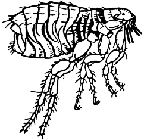
|  |
The bodies of fleas are shaped for their particular way of life.They are small,wingless and flat from side to side. Adult fleas vary in size from 1 /25 to 1 /4 inch (1 to6.3 mm) and are black to brownish-black in color. Their legs are relatively long for jumping. They can jump 7to 8 inches vertically and14 or 15 inches horizontally. Their mouthparts can pierce the skin and suck blood.The hard, smooth body is covered with backward pointing bristles and spines that help the flea to move easily through hairs or feathers of an animal. Fleas are easily disturbed while feeding and will run quickly or jump away to escape.
Medical importanceFlea bites are extremely annoying. Flea bites are usually not felt immediately, but become sore and more irritating afterward, depending on the sensitivity of the person or animal. Dogs and cats will scratch constantly when infested. Their coats become dirty and rough; their skin becomes irritated. Summer eczema, a skin condition of dog , may be associated in someway with fleas.
Fleas usually bite people on the legs and ankles;often two or three bites in a row. The bite is a small red spot with a light-colored center. To relieve the itching, apply cooling preparations such as carbolated vaseline, menthol, camphor,calamine lotion or ice. See a doctor immediately if you have a severe allergic reaction.
Spreading disease organisms to man and animals is very possible because fleas bite many different people and animals. Fleas can transmit two types of bubonic plague-urban and rural. Urban plague is spread by close contact between people and animals, especially rats or their fleas. Rural plague involves wild rodents and fleas, with occasional transmission to man. Rural plague is present in the western United States.
Murine or endemic typhus also is transmitted from rats to man. This disease occurs only occasionally in the western United States.
How to control fleas
Successful flea control must include treatment of the following:
|
These treatments must be done at the same time in order to be effective. If you do not treat one of the sites, it will provide a hiding place for fleas and result in a new infestation.
PetsWash all pet bedding thoroughly or throw it away. Use a shampoo or dust insecticide instead of sprays for treating pets. Apply dusts with a shaker or rub them into the hair by and. Be sure to wear latex or rubber gloves and keep the dust out of the animal's eyes, nostrils and mouth. Treat the animal thoroughly around the ears, between the legs and around the tail. Flea collars with insecticide are minimally effective for controlling fleas on pets. Before you use these products, always read the label for information that may be important to the health and safety of your pet. It is more convenient and safe to have a veterinarian treat pets for fleas.
OutdoorsTreat infested outdoor areas such as garages,porches and yards thoroughly to prevent re-infestation of pets. Prevent pets and other animals from getting under the house so that this area doesn't become infested. Eliminate rats and mice, and use a good flea control program in areas where they are found.
InsideControlling fleas in the home requires effort from the homeowner. First, inspect the area. You can usually find adult fleas by walking through the house wearing white socks. The adult fleas will jump onto the white socks where they can be spotted. Begin with a thorough cleaning of the house to eliminate the flea at any stage of development. Use a vacuum cleaner to clean carpets, rugs, cracks and crevices in floors,baseboards and areas under furniture. After you finish, burn the vacuum bag or place it in an airtight plastic bag and throw it away.
Apply a spray insecticide to floors, molding and baseboards up to a height of 1 foot. Also apply to furniture and specific areas where pets rest or sleep. The effectiveness of insecticides is directly related to the thoroughness of applications. Repeat applications in about 3 weeks to kill fleas that had not hatched at the time of treatment.
Always read and follow carefully the instructions on the container label. Pest control companies offer effective flea control services if you do not want to apply pesticides yourself.
For more information about treating your home,yard and pets for severe infestations, contact your local county Extension office.
Las pulgas se encuentran por todo el mundo.Infestan a pájaros y mamíferos, inclusive alhombre, y abundan en los roedores. La especiemás comén que se encuentra en Texas es lapulga de gato o en inglés "cat flea". Las pulgasson una preocupación para la salud porqueexisten en grandes números en casi todo elmundo y transmiten enfermedades a través desus mordeduras molestas.
¿Cómo son las pulgas?Importancia médica
Cómo controlar las pulgas
Un
control de pulgas exitoso tiene que incluirel tratamiento
de:
|
|
Texas
Agricultural Extension Service · The Texas A&M
University System |
Adapted
from TAEX publication L-1738 Fleas for your use by Ana A. DeLuna,
Extension Assistant in Communications. Graphic design by Rhonda
R. Kappler
.Una
Vida Mejor project activities are supported by a grantfrom
the W. K. Kellogg Foundation.
Educational
programs conducted by the Texas AgriculturalExtension Service
serve people of all ages regardless ofsocioeconomic level,
race, color, sex, religion, handicap, ornational origin.
Adaptado y traducido de la publicación Fleas L-1738
delServicio de Extensión Agrícola de Texas para
su uso porAna A. DeLuna, Asistente de Extensión en
Comunicaciones.Diseño gráfico por Rhonda R.
Kappler.
Actividades
para el proyecto Una Vida Mejor sonpatrocinadas por una subvención
de la Fundación W. K.Kellogg.
Los
programas educativos dirigidos por el Servicio deExtensión
Agrícola de Texas sirven a personas de todas las dades
sin distinción del nivel socioeconómico, raza,
color,sexo, religión, impedimento u origen nacional.
Disclaimer and Reproduction Information: Information in NASD does not represent NIOSH policy. Information included in NASD appears by permission of the author and/or copyright holder. More